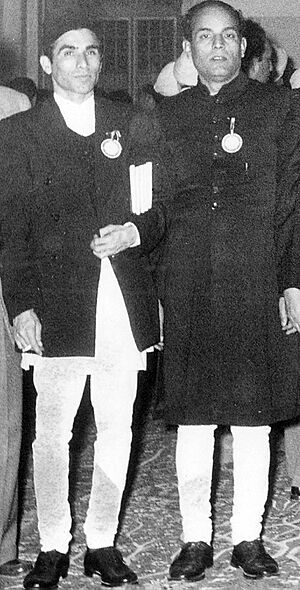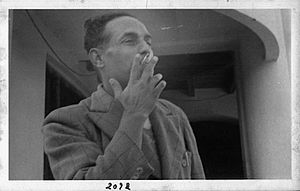Laxmi Prasad Devkota facts for kids
Quick facts for kids
Mahakavi
Laxmi Prasad Devkota
|
|
|---|---|
|
लक्ष्मीप्रसाद देवकोटा
|
|

about
|
|
| Minister of Education and Autonomy | |
| In office 26 July 1957 – 15 May 1958 |
|
| Monarch | King Mahendra |
| Prime Minister | Kunwar Inderjit Singh |
| Personal details | |
| Born | 13 November 1909 Dhobidhara, Kathmandu, Nepal |
| Died | 14 September 1959 (aged 49) Pashupati Aryaghat |
| Nationality | Nepali |
| Spouse | Mandevi Chalise |
| Children | 5 daughters and 4 sons |
| Parents | Tilmadhav Devkota (father) Amar Rajya Lakshmi Devi (mother) |
| Relatives | Lok Priya Devi (sister) |
| Occupation | Poet, Playwright and Scholar |
Laxmi Prasad Devkota (Nepali: लक्ष्मीप्रसाद देवकोटा) (1909-1959) was a famous Nepali poet, playwright, and novelist. He was given the special title of Mahakavi (meaning 'Great Poet') in Nepali literature. People called him a poet with a golden heart. Many people think he is the greatest and most famous writer in Nepal. Some of his well-known works include the best-selling Muna Madan, along with Sulochana, Kunjini, Bhikhari, and Shakuntala.
Contents
Discovering Laxmi Prasad Devkota's Life
Early Years and Education
Devkota was born on November 13, 1909, during the night of Lakshmi Pujan. His parents were Teel Madhav Devkota and Amar Rajya Lakshmi Devi. He was born in Dhobidhara, Kathmandu. His father was a Sanskrit scholar, so Laxmi Prasad learned a lot from him at home.
He started his formal schooling at Durbar High School. There, he studied both Sanskrit grammar and English. When he was 17, he finished his high school exams in Patna. Later, he studied for a Bachelor of Arts degree and a Bachelor of Laws degree at Tri-Chandra College. He graduated from Patna University. He wanted to get a master's degree, but his family's money problems stopped him.
About ten years after becoming a lawyer, he started working at the Nepal Bhasaanuwad Parishad (Publication Censor Board). There, he met the famous playwright Balkrishna Sama. At the same time, he also taught as a lecturer at Tri-Chandra College and Padma Kanya College.
Family Life
Devkota's son, Padma Devkota, also became a poet and writer. He worked for many years as a professor at Tribhuvan University in Kathmandu.
Health Struggles
In the late 1930s, Devkota faced some health challenges. This was likely due to the sad deaths of his parents and his two-month-old daughter. In 1939, he spent five months in a mental asylum in Ranchi, India. Later in his life, he had money problems. This made it hard for him to pay for his daughters' weddings.
Later Years and Passing
Laxmi Prasad Devkota passed away on September 14, 1959. He died after a long illness at Pashupati Aryaghat, which is by the Bagmati river in Pashupatinath Temple, Kathmandu. Before he died, the Nepal Academy of Literature and Art stopped paying him. This happened because he went to a writers' conference in Tashkent without their permission. At the conference, he praised other Nepali writers like Bhanubhakta Acharya and Lekhnath Paudyal. Devkota said in an interview that he hadn't been paid for eight months. This meant he couldn't buy his medicine or even enough food. Even though he was very sick, Devkota was known for his lively and strong personality.
Devkota's Writing Style and Impact
Devkota helped start a new romantic movement in Nepali literature. He was the second writer in Nepal to create long epic poems in the Nepali language. His new ways of using language helped Nepali poetry reach amazing new levels.
Muna Madan: A Popular Epic
Devkota moved away from the old Sanskrit style that was common in Nepali writing. He was inspired by a Newar language folk song called Ji Waya La Lachhi Maduni. This led him to write Muna Madan (Nepali: मुनामदन) in 1930. It's a long story poem written in a popular folk tune called Jhyaure bhaka (Nepali: झ्याउरे भाका).
Muna Madan is the best-selling book in Nepali literature history. In 2003, a film based on this poem, Muna Madan, was Nepal's official entry for the Academy Award for Best Foreign Language Film. The rulers of Nepal at the time, the Ranas, quickly recognized the work.
Muna Madan tells the story of Madan, a traveling merchant. He goes to Tibet to earn money, leaving his wife, Muna, behind. The poem describes the difficulties of his journey. It also shows the sadness of being separated, the pain of missing someone, and the sorrow of death.
The original folk song, Ji Waya La Lachhi Maduni, is a sad song about a Newa merchant, his mother, and his wife. The merchant is about to leave Kathmandu for Tibet for work. The song begins with the wife asking her mother-in-law to stop him. She says it hasn't even been a month since she came to their home, and he wants to leave.
Devkota grew up in Kathmandu and often heard this song sung by locals. He loved the song and decided to rewrite it in Nepali. At that time, the Rana rulers had banned Newa trade, language, and literature. So, Devkota changed the main character from a Newa merchant to a Kshatriya (warrior class) character. Even though Kshatriya people didn't usually trade for a living back then, he had to show it this way to please the Rana rulers.
The following lines are very famous from the poem. They show how humanity and kindness are more important than social classes in Nepalese culture:
|
"क्षेत्रीको छोरो यो पाउ छुन्छ, घिनले छुँदैन |
The son of a Kshatriya touches your feet not with hatred but with love. |
Muna Madan is seen as Devkota's greatest work. It has stayed very popular among Nepali readers since 1936. The book was also translated into Mandarin and was well-received in China.
Pagal: A Poem of the Mind
Devkota was inspired by his five-month stay in a mental asylum in 1939. This led him to write a free-verse poem called Pagal (Nepali: पागल, lit. 'The Lunatic'). This poem talks about his own mental state and is considered one of the best Nepali poems.
|
"जरुर साथी म पागल ! |
Surely, my friend, I am mad, |
Devkota had a special talent for writing long epic poems and complex works very quickly. For example, he wrote Shakuntala, his first epic poem and the first Mahakavya (Nepali: महाकाव्य) in Nepali, in just three months. Published in 1945, Shakuntala is a huge work with 24 parts. It is based on Kālidāsa's famous Sanskrit play Abhijñānaśākuntalam. Shakuntala shows how well Devkota understood Sanskrit poetry. He used many Sanskrit styles while writing mainly in Nepali.
According to scholar David Rubin, Shakuntala is one of Devkota's greatest achievements. He called it "a remarkable work, a masterpiece... harmonizing various elements of a classical tradition with a modern point of view."
Other Poetic Works
Devkota also published several collections of shorter poems. These poems used different traditional and new styles. Many of his poems show the influence of English Romantic poets like Wordsworth and Coleridge.
The main poem in the collection Bhikhari (Nepali: भिखारी, lit. 'Beggar') reminds us of Wordsworth's "The Old Cumberland Beggar". In this poem, Devkota describes a beggar living in extreme poverty and loneliness. This beggar lacks human love and comfort. Yet, the beggar is also seen as a source of kindness, found even in suffering. Devkota connects the beggar to a divine source of compassion:
|
"कालो बादलबाट खसेको |
Fallen from the blackest clouds |

Many of his poems focus on everyday things in human life and nature. Titles like Ban (Nepali: वन, lit. 'The Woods'), Kisaan (Nepali: किसान, lit. 'The Peasant'), and Baadal (Nepali: बादल, lit. 'Clouds') show that he found inspiration in simple, nearby parts of the world. What stands out in most of his poetry is his deep belief in humanity.
For example, in the poem Ban, the speaker asks many questions. He rejects any comfort that would only be for him as an individual. Instead, he cares deeply for other people. The poem ends with these lines that show his focus on humanity:
|
"दोस्त कहाँ छन्? साथ छ को को? घर हो तिम्रो कुन देश? |
Where are your friends? Who goes with you? Which land is your home? |
Contributions to Essays
Besides poetry, Devkota also wrote many important essays. He is seen as the founder of modern Nepali essay writing. He changed the usual way essays were written. He used a more natural and everyday style that was clearer, more emotional, and well-spoken. His essays often used humor to criticize how Western ideas were changing Nepali society.
In an essay called Bhaladmi (Nepali: भलादमी, lit. 'Gentleman'), he criticized the trend in Nepali society to judge people by their looks and clothes instead of their true worth. In another essay, Ke Nepal Sano Cha? (Nepali: के नेपाल सानो छ?, lit. 'Is Nepal is small'), he showed strong national pride. He spoke against the influence of British India, which he felt was affecting Nepali culture. His essays are collected in a book called Laxmi Nibhandha Sanghraha (Nepali: लक्ष्मी निबन्धसङ्ग्रह).
Devkota also translated William Shakespeare's play Hamlet into Nepali. He even translated his own epic, Shakuntala, into English. He wrote several poems, essays, plays, and epics in English too.
Devkota's Role in Politics
Laxmi Prasad Devkota was not part of a specific political party. However, his poems often showed his disagreement with the unfair rule of the Rana dynasty. When he was living away from Nepal in Varanasi, he worked as an editor for the Yugvani newspaper, which belonged to the Nepali Congress. Because of this, the Rana Government took away all his property in Nepal.
After democracy was brought to Nepal through the Revolution of 1951, King Tribhuvan appointed Devkota as a member of the Nepal Salahkar Samiti (Nepali: नेपाल सलाहकार समिति, lit. 'Nepal Advisory Committee') in 1952. Later, in 1957, he became the Minister of Education and Autonomous Governance. This was under the leadership of Prime Minister Kunwar Inderjit Singh.
See also
 In Spanish: Laxmi Prasad Devkota para niños
In Spanish: Laxmi Prasad Devkota para niños
- Nepali literature
- Bhanubhakta Acharya
- Mahakavi Devkota




